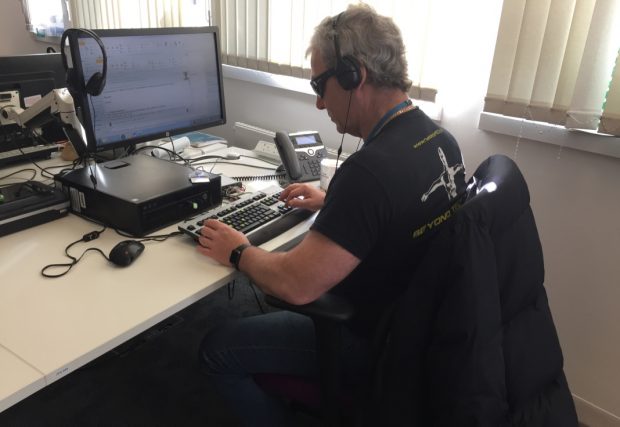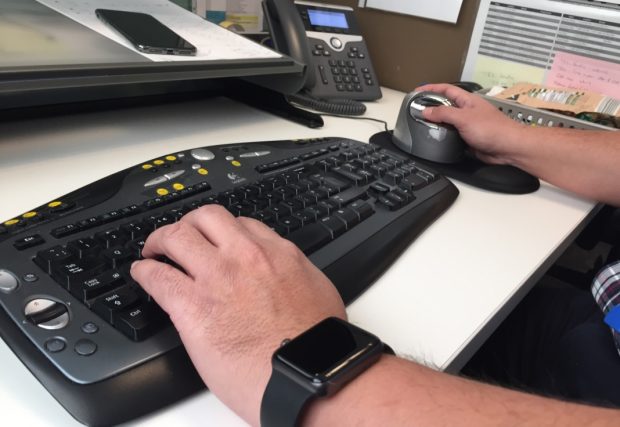
Last year I tested a new DWP service that would be used by colleagues in jobcentres while dealing with customers. We tested the service with jobcentre staff, including people who used various assistive technologies.
Testing proved the service to be accessible (bar a few tweaks) but I came away with some unexpected learnings.
By speaking with only a handful of colleagues that used assistive technologies it became apparent that there were a number of fundamental problems that existed separately to the digital service.
It seemed that there was more to do with this group of users to fully meet their needs.
Further research (both quantitative and qualitative) with nearly 100 DWP assistive technology users by phone and email supported my initial findings. Here’s what I learnt:
1. Assistive technology can be socially, physically and emotionally isolating
Wearing headphones physically cuts the users off from the environment and users of voice recognition technologies tell us they are often situated away from the main team.
Lower targets, limited job roles and variation of work within those roles and a perceived lack of career opportunities all lend themselves to a sense by some users that they are less valuable and valued than their colleagues.
These users often expressed a desire to be seen and treated the same as everyone else. This sometimes led to them not asking for support when they needed it. This can be further exacerbated (but not always) if colleagues are uninformed or embarrassed about the person’s condition.
2. Users of assistive technology find inventive ways to help themselves
People have their own strategies to help them do their job in addition to assistive technologies. These are specific to the individual, their condition, their personal preferences and the job that they do as much as, if not more, than the assistive technology they use.
For example, users who have visual impairments may rely on memory to finding content on screen. One user with cognitive impairments told me she uses pencils to tap the keyboard rather than her fingers.
3. Assistive technology can be hard to source and set up
Provision of kit takes time and existing kit is not always compatible with the latest assistive technology software. It can also take up a lot of room - sourcing a desk big enough for some users is often their biggest challenge.
During my research I heard that some assistive technology users avoid moving jobs because of the problems they experience moving existing kit or arranging for new kit.

4. Training, support and organisational culture are crucial
Training for assistive technologies needs to account for the multitude of individual people’s conditions, how they will use the technology and what they will use it for. Plus, there needs to be recognition of the fact that assistive technology users’ needs may change over time.
To make assistive technology really work for users, it helps if there is a consistent approach by managers towards those users, and if formal or informal support groups are in place.
5. When assistive technology breaks, it really breaks
If users of assistive technology experience catastrophic system crashes it often results in them being offline for long periods doing alternative tasks while they wait for their kit to be rebuilt. Fear of this scenario understandably creates a huge disincentive for users to try or learn anything new with their assistive technology.
Issues like this can lead to assistive technology users suffering from low morale, a lack of motivation and poor physical and mental health. That’s why it’s so important that technical downtime is kept to a minimum.
Improving the experience of assistive technology users in DWP
Although my research with assistive technology users was a bi-product of the original piece of research, it was very revealing.
In DWP we do have work to do to improve digital technology and ways of working across the organisation to reduce barriers faced by people who use assistive technology.
The good news is our accessibility team are focused on creating the right environments and technology to make sure those who use assistive technology have the same opportunities and positive work experience as those that do not.
Like this blog? Why not subscribe for more blogs like this? Sign up for email updates whenever new content is posted!

1 comment
Comment by Tara G posted on
Hello Jude, really interesting observations. It feels so frustrating and so wrong that colleagues using assistive technology feel unable to ask for help and feel they are treated differently form their colleagues.
I also wonder if people using assistive technology are not asked for help from their colleagues?